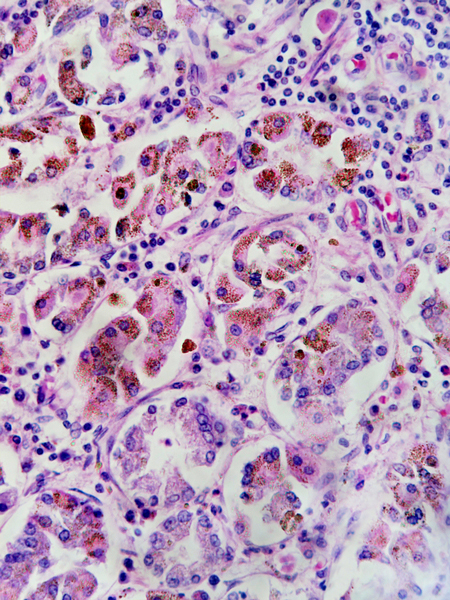CRISPR 2.0 Is Here, and It’s Way More Precise

You’ve probably heard of the molecular scalpel CRISPR-Cas9, which can edit or delete whole genes. Now, scientists have developed a more precise version of the DNA-editing tool that can repair even smaller segments of a person’s genome.
In two studies published today, one in Nature and another in Science, researchers from the Broad Institute of MIT and Harvard describe a new way to edit DNA and RNA, called base editing. The approach could one day treat a range of inherited diseases, some of which currently have no treatment options.
The human genome contains six billion DNA letters, or chemical bases known as A, C, G and T. These letters pair off—A with T and C with G—to form DNA’s double helix. Base editing, which uses a modified version of CRISPR, is able to change a single one of these letters at a time without making breaks to DNA’s structure.
That’s useful because sometimes just one base pair in a long strand of DNA gets swapped, deleted, or inserted—a phenomenon called a point mutation. Point mutations make up 32,000 of the 50,000 changes in the human genome known to be associated with diseases.
In the Nature study, researchers led by David Liu, a Harvard chemistry professor and member of the Broad Institute, were able to change an A into a G. Such a change would address about half the 32,000 known point mutations that cause disease.
To do it, they modified CRISPR so that it would target just a single base. The editing tool was able to rearrange the atoms in an A so that it instead resembled a G, tricking cells into fixing the other DNA strand to complete the switch. As a result, an A-T base pair became a G-C one. The technique essentially rewrites errors in the genetic code instead of cutting and replacing whole chunks of DNA.
“Standard genome-editing methods, including the use of CRISPR-Cas9, make double-stranded breaks in DNA, which is especially useful when the goal is to insert or delete DNA bases,” Liu said on a conference call with journalists on Tuesday. “But when the goal is to simply fix a point mutation, base editing offers a more efficient and cleaner solution.”
Liu said base editing isn’t meant to be a replacement to traditional gene editing with CRISPR, but rather another option for altering the genome in an attempt to correct disease. If CRISPR is akin to a pair of scissors, base editing is more like a pencil, he said.
Previously, researchers had created base editors capable of making the opposite kind of swap—changing a G into an A. Substitutions of a G for an A in certain parts of the DNA represent about 15 percent of disease-associated point mutations. In September, Chinese researchers reported that they used one of these editing tools in an embryo to remove the genetic mutation that causes anemia.
Working in cells taken from patients, Liu and his colleagues used their base-editing tool to correct a point mutation that causes hereditary hemochromatosis, a disorder that causes the body to absorb too much iron from food. This excess iron can build up over time and cause liver cancer and other liver diseases, diabetes, heart disease, or joint disease.
Liu and his team also used the base editor in human cells to induce a mutation that suppresses sickle-cell anemia. In both studies, they detected virtually no off-target effects, or unwanted DNA insertions or deletions, which are a concern with the traditional way of using CRISPR to edit entire genes.
In the new Science study, Feng Zhang, of the Broad Institute and MIT, used a similar base-editing method to target individual letters in RNA, DNA’s chemical cousin. RNA naturally degrades in the body, so editing RNA wouldn’t result in a permanent change to a person’s genome.
Ross Wilson, of the Innovative Genomics Institute at the University of California, Berkeley, says base editing may eventually be a better way to treat some diseases. He says a single base pair is like a word in a paragraph of text. With conventional CRISPR technology, you would have to replace the whole paragraph.
“It’s a lot of DNA to move around,” he says. With base editing, you could just change the single word.
Liu says he’s hopeful that base editing of DNA and RNA could be used as complementary approaches for a “broad set of potential therapeutic applications.”
His lab is exploring base editing to fix blood disorders, neurological disorders, hereditary deafness, and hereditary blindness.
Deep Dive
Biotechnology and health
How scientists traced a mysterious covid case back to six toilets
When wastewater surveillance turns into a hunt for a single infected individual, the ethics get tricky.
An AI-driven “factory of drugs” claims to have hit a big milestone
Insilico is part of a wave of companies betting on AI as the "next amazing revolution" in biology
The quest to legitimize longevity medicine
Longevity clinics offer a mix of services that largely cater to the wealthy. Now there’s a push to establish their work as a credible medical field.
There is a new most expensive drug in the world. Price tag: $4.25 million
But will the latest gene therapy suffer the curse of the costliest drug?
Stay connected
Get the latest updates from
MIT Technology Review
Discover special offers, top stories, upcoming events, and more.